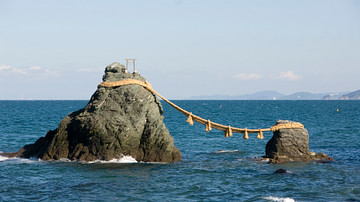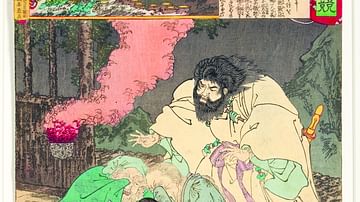
Yomi, or Yomi-tsu-kuni, is the underworld of the Shinto religion, even if it forms no part of Shinto theology and appears only in ancient myths as told in the 8th-century CE Kojiki, notably the story of the creator gods Izanami and Izanagi. Shinto is largely concerned with the here and now of the living so that Yomi, unlike say the Christian notion of Hell, has only a limited significance related to the physical decay of believers after death.
Yomi in Mythology
Yomi ('Land of Darkness'), also known as Ne-no-kuni ('Land of Roots') or Soko-no-kuni ('Hollow Land'), was imagined to be the place beneath the earth where the souls of the dead gathered. There were thought to be two entrances to Yomi, one, a mere hole in the ground in the province of Izumo blocked by a boulder, and another more dramatic entrance where all the seas plunge down into the earth.
Izanami & Izanagi
Yomi features prominently in two Shinto myths. The first involves Izanami and Izanagi, the gods who created the islands of Japan. The couple also parented many of the other gods; the birth of some came at a certain price, though. Izanami was terribly burnt when she gave birth to Kagutsuchi the fire god, and it is said that many more gods were born from her tears as she suffered from her injuries until, finally, she died.
Izanagi, unable to live without his beloved wife, rashly followed her down into the underworld. Unfortunately, he was unable to rescue her as she had already eaten food in Yomi and so was forbidden from returning to the realm of the living. However, Izanami pleaded with the gods to be made an exception of and made Izanagi promise that he would be patient and not try to see her in her present state. The process of release was long, however, and an impatient Izanagi could wait no more and so he attempted to see his beloved. He was in for a shock, though, for when he saw her, the body of the goddess was already decomposing. Izanami was more than displeased at her husband breaking his promise and seeing her in such a state, but worse, the Eight Thunders and the Ugly Females which came from Izanami's hair chased the god out of the underworld. In other versions, Izanagi flees in terror at the disgusting sight of Izanami. During his retreat, Izanagi stopped the pursuing Thunders by throwing his stick (kunado-no-kami) in their path and brandishing three peaches, a fruit thought to possess magical properties. On finally reaching the outside world, Izanagi blocked the entrance to Yomi with an enormous stone, and Izanami was left to her fate.
Fortunate to escape unharmed from such a terrible place, the god had to perform a cleansing ritual in the river Woto to rid himself of the impurities of Yomi. It was during these rituals that various gods were born: Amaterasu, the sun goddess, when he washed his left eye, Tsuki-yomi, the god of the moon, when he washed his right eye, Susanoo the storm god, when he washed his nose, and Shina-tsu-hiko, the god of wind, was born from Izanagi's breath. In addition, when he cast off his tainted clothes in the river a further twelve gods were born from the twelve pieces. In reference to this episode, the practice of harai or cleansing before entering a sacred shrine (jinja) has become an important part of Shinto ritual where cleanliness and purification are especially esteemed.
Susanoo & Okuninushi
The second myth to feature Yomi is the story of the gods Susanoo and Okuninushi. In some versions, Susanoo resides in Yomi alongside his mother Izanami, in a palace near the underworld's entrance. The storm god was banished there because he had shown excessive grief for the passing of his mother. Susanoo was visited one day by Okuninushi, a god and sixth-generation descendant of the storm god. Okuninushi was being troubled by his 80 brothers and so sought the advice of Susanoo.
On arriving at the palace Okuninushi was distracted by the beauty of Susanoo's daughter Suseri-hume and promptly married her. Susanoo was livid when he discovered what had passed without his permission and so he set a fearsome test for his new son-in-law. Okuninushi was required to sleep in a room full of snakes, bees, and centipedes, creatures strongly associated with Yomi. Fortunately, Suseri-hume saved her husband from his ordeal, but Susanoo next asked Okuninushi to comb his hair and check for lice as a mark of his respect. Okuninushi complied and found not lice but lethal centipedes crawling about his father-in-law's locks. Again, he was saved by his wife, who gave him red clay and nuts which he chewed and spat out, thus making it seem he was ridding Susanoo of his centipedes. When the storm god fell asleep, Okuninushi tied his hair to the rafters and he and Suseri-hume escaped back to the land of the living. With Susanoo's sword and bow, which he had stolen, Okuninushi was able to defeat his 80 brothers and set himself up as ruler of the world, a reign which lasted until Amaterasu sent down her grandson Ninigi to take his place.
Shinto: Life After Death
In no ancient Shinto textual source is it explained who exactly goes to Yomi and why. Some historians suggest that the concept of a life after death was not a familiar one to the ancient Japanese and it only took form with the introduction of Buddhism from China in the 6th century CE. Yomi certainly has a very limited place in Shinto thought where a life after death is only vaguely alluded to and where there is an absence of a general concept of punishment and reward for souls in the next life as found in many other religions. The only suffering of souls in Yomi, if indeed there is any at all, is their separation from their living loved ones. The noted Shinto scholar and theologian Hirata Atsutane (1776-1843 CE) explains Yomi and its limited significance thus,
The old legends that dead souls go to Yomi cannot be proven. Then it may be asked, where do the souls of the Japanese go when they die? It may be clearly seen from the purport of ancient legends and from modern examples that they remain eternally in Japan and serve in the realm of the dead governed by Okuninushi-no-kami. This realm of the dead is not in any one particular place in the visible world, but being a realm of the darkness and separated from the present world, it cannot be seen…
The darkness, however, is only comparative. It should not mistakenly be imagined that this realm is devoid of light. It has food, clothing, and houses of various kinds, similar to those of the visible world. Proof of this may be found in accounts…in which a person has occasionally returned to tell of the realm of the dead.
After death the soul leaves the body and resides in the area of the grave, a fact attested by countless accounts…of both ancient and modern times of miraculous occurrences by spirits in the vicinity of graves…Some say that the soul goes to the filthy realm of Yomi, but there is not a shred of evidence that this is the case. (Scott Littleton, 94)
This content was made possible with generous support from the Great Britain Sasakawa Foundation.





